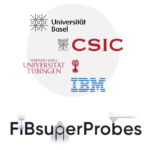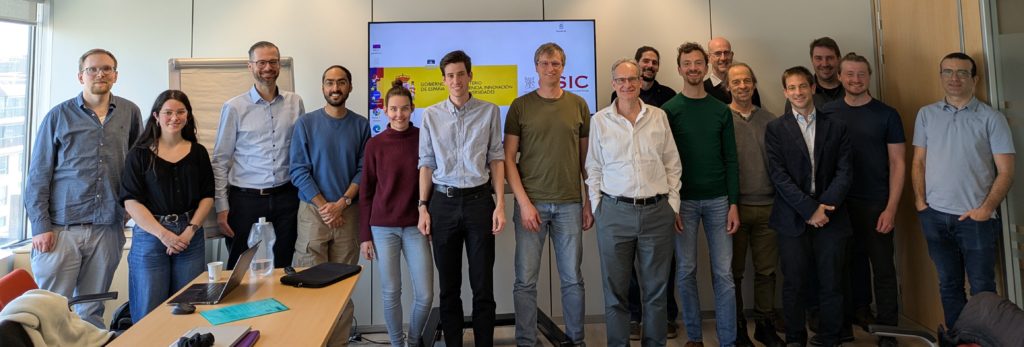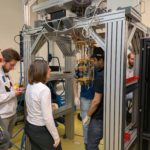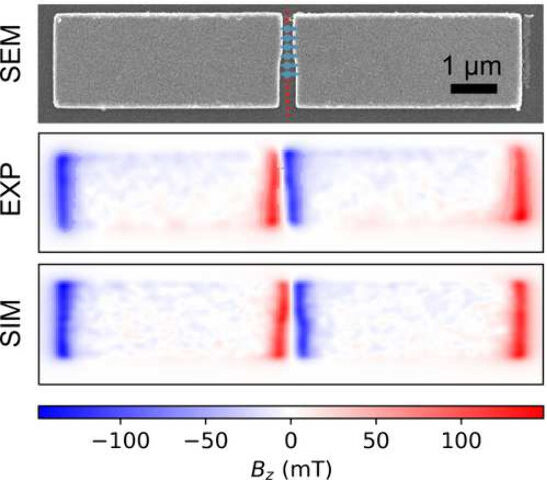Current News
June 2025
Spin Dynamics GRC in Les Diablerets
From the 29th to July 3rd, Prof. Poggio attended the Spin Dynamics in Nanostructures Gordon Research Conference in Les Diablerets, Switzerland. The workshop was dedicated to the most recent and counter-intuitive examples of magnetism and spin dynamics, as well as to applications of fundamental research to data storage, memory, and computing hardware. Prof. Poggio gave an invited talk on the evening of the 29th entitled, “Nanoscale scanning probe microscopy of 2D magnetism”.
Group Members at SPIN Annual Meeting
From the 18th to the 20th, Ph.D. students Luca Forrer, Aurèle Kamber, Daniel Jetter, and research scientist Dr. Floris Braakman attended the 5th Annual Meeting of the NCCR SPIN in Pontresina, Switzerland. Luca and Aurèle presented a poster entitled, “Scanning nanowire quantum dot” on the evenings of the 18th and 19th. On the afternoon of the 18th, Daniel gave an ‘innovation pitch’.
Group Members at Spin Phenomena Workshop
From the 17th to the 19th, research scientist Dr. Paritosh Karnatak and Prof. Poggio attended the Quantum Functionalities of Nanomagnets workshop in Ingelheim, Germany. The workshop aimed to discuss the quantum aspects of tailored magnetic platforms, whose main advantage lies in the high degree of control in manipulation, preparation, parameter tunability, and all-magnetic device integration. Paritosh presented a poster and Prof. Poggio gave a tutorial talk on the afternoon of the 17th entitled, “Magnetic imaging on the nanometer scale”.
Prof. Poggio in Hamburg
Prof. Poggio traveled to Hamburg, Germany on the invitation of Prof. Philip Moll of the Max Planck Institute for the Structure and Dynamics of Matter to give the “Hamburg Photon Science Colloquium” on the afternoon of the 6th. The colloquium series is jointly organized by all photon science organizations and research cooperations on the Campus Bahrenfeld. Prof. Poggio gave a talk entitled, “Imaging vdW magnets and magnetic devices in the 2D limit”.
May 2025
Estefani Leaves to Take Independent Scientist Position at CBPF
 The 31st was Dr. Estefani Marchiori’s last day as a post-doctoral researcher in our group. Estefani started work in the lab back in July 2019 after earning her Ph.D. from the University of Bath studying the interplay between ferromagnetism and superconductivity using scanning Hall microscopy under Prof. Simon Bending. Upon starting in Basel, she led our efforts imaging both superconductivity and magnetism using scanning SQUID-on-tip sensors. During this time, she also helped develop a new, more convenient, more robust, and more flexible method for fabricating SQUID-on-tip sensors.
The 31st was Dr. Estefani Marchiori’s last day as a post-doctoral researcher in our group. Estefani started work in the lab back in July 2019 after earning her Ph.D. from the University of Bath studying the interplay between ferromagnetism and superconductivity using scanning Hall microscopy under Prof. Simon Bending. Upon starting in Basel, she led our efforts imaging both superconductivity and magnetism using scanning SQUID-on-tip sensors. During this time, she also helped develop a new, more convenient, more robust, and more flexible method for fabricating SQUID-on-tip sensors.
Estefani is now moving on to start a new adventure as an independent scientist at the Centro Brasileiro de Pesquisas Físicas (CBPF) in Rio de Janeiro, Brazil. Thank you for everything, good luck, and we look forward to work together in the future!
Paper on Imaging of Ferromagnetic Superconductor Appears
 On the 31st, Communications Materials published our paper written in collaboration with Prof. Simon Bending and Dr. Joe Wilcox from the University of Bath on imaging vortex dynamics in a ferromagnetic superconductor. The paper entitled, Magnetically controlled vortex dynamics in a ferromagnetic superconductor, presents measurements of EuFe2(As1-xPx)2, a superconductor with a maximum critical temperature of 25 K that exhibits full coexistence with ferromagnetic order below 19 K. The interplay between superconductivity and ferromagnetism in this material leads to narrowing of ferromagnetic domains at higher temperatures and spontaneous nucleation of vortices and antivortices at lower temperatures. In the paper, we demonstrate how the underlying magnetic structure controls the superconducting vortex dynamics in applied magnetic fields. Just below the ferromagnetic ordering temperature we observe a pronounced peak in the creep activation energy, and magnetic force microscopy measurements reveal the presence of very closely spaced vortex clusters. We attribute these observations to the formation of vortex polarons, for which we present a theoretical description. In contrast, we link strong magnetic irreversibility at low temperatures to a critical current governed by giant flux creep over an activation barrier for vortex-antivortex annihilation near domain walls. The work suggests new routes for the magnetic enhancement of vortex pinning with important applications in high-current conductors.
On the 31st, Communications Materials published our paper written in collaboration with Prof. Simon Bending and Dr. Joe Wilcox from the University of Bath on imaging vortex dynamics in a ferromagnetic superconductor. The paper entitled, Magnetically controlled vortex dynamics in a ferromagnetic superconductor, presents measurements of EuFe2(As1-xPx)2, a superconductor with a maximum critical temperature of 25 K that exhibits full coexistence with ferromagnetic order below 19 K. The interplay between superconductivity and ferromagnetism in this material leads to narrowing of ferromagnetic domains at higher temperatures and spontaneous nucleation of vortices and antivortices at lower temperatures. In the paper, we demonstrate how the underlying magnetic structure controls the superconducting vortex dynamics in applied magnetic fields. Just below the ferromagnetic ordering temperature we observe a pronounced peak in the creep activation energy, and magnetic force microscopy measurements reveal the presence of very closely spaced vortex clusters. We attribute these observations to the formation of vortex polarons, for which we present a theoretical description. In contrast, we link strong magnetic irreversibility at low temperatures to a critical current governed by giant flux creep over an activation barrier for vortex-antivortex annihilation near domain walls. The work suggests new routes for the magnetic enhancement of vortex pinning with important applications in high-current conductors.
The magnetic force microscopy experiments using ultrasenstive nanowire-based probes were carried out in our Basel lab by Ph.D. student Lukas Schneider and post-doctoral researcher Dr. Estefani Marchiori. Collaborators from the group of Prof. Raffi Budakian grew the Si nanowires that were functionalized with magnetic tips via focused-electron-beam-induced deposition in Basel. Dr. Marchiori led the Basel part of the work and Dr. Wilcox and Prof. Bending initiated and coordinated the overall collaboration, which included sample growth from the University of Tokyo, theoretical work from the University of Bordeaux, and magnetometry measurments in Bath and at the University of Bristol.
Prof. Poggio at Summer School in Lecce
On the 30th Prof. Poggio gave a talk at the Quantum Optics and Quantum Materials summer school in Lecce, Italy. The school took place from the 26th to the 30th and was aimed at Ph.D. students and post-doctoral researchers in the fields of quantum technology, quantum optics, many-body physics, quantum materials, quantum information, quantum magnetism, spintronics, and superconductivity. Prof. Poggio gave the last talk, which was entitled, “Imaging quantum magnetism.”
Loris at School in Benasque
From the 21st to 30th, Ph.D. student Loris Durante attended the Spring School on Superconducting Qubit Technology in Benasque, Spain. The school aimed to cover a broad range among those subjects needed for a quantum physicist or engineer to work with superconducting devices. Expert speakers from universities, research institutes, and companies, were invited to cover not only the basics but also the specific techniques required to design, fabricate, and operate quantum devices based on superconducting circuits. Loris presented a poster on the 22nd entitled, “Scanning SQUID Microscopy with Nanometer Spatial Resolution of Superconducting Materials Using SQUID-on-Tip and -Lever.”
Group Members in Grenoble
From the 20th to the 23rd, research scientists Dr. Floris Braakman and Dr. Paritosh Karnatak attended the Quantum Matter International Conference (QUANTUMatter 2025) in Grenoble, France. The conference aimed at gathering the various communities engaged in the science and technologies of quantum information and quantum matter, to foster the incubation of new ideas and collaborations at the forefront of quantum technologies, emerging quantum materials, and novel generations of quantum communication protocols, quantum sensing and quantum simulation. Paritosh gave a talk on the 21st entitled, “Probing the magnetic order in a ferromagnetic monolayer”.
Jiří Pospíšil Visits the Group
On the 12th and 13th, Dr. Jiří Pospíšil from Charles University in Prague visited our group. He gave a talk at our department’s Quantum and Nano Seminar on the afternoon of the 12th entitled, “Peculiar properties of van der Walls ferromagnet VI3“.
Andriani Earns Ph.D. and Marco Gibertini Visits
On the 5th, Ph.D. student Andriani Vervelaki defended her thesis entitled, “Probing 2D magnetism using scanning SQUID microscopy”, earning her doctorate in physics summa cum laude. The defense was chaired by Prof. Patrick Maletinsky with Prof. Marco Gibertini (Modena), Prof. Semonti Bhattacharyya (Leiden) — joining via video link — Prof. Ilaria Zardo, and Prof. Poggio making up the committee of experts. Andriani joined the lab in November of 2020 after receiving her Bachelor and Masters of Science in 2018 and 2020, respectively, both from Crete University. Contgralations to Dr. Vervelaki!
Our external expert, Prof. Marco Gibertini visited the lab and department on the 5th and 6th. On the afternoon of the 5th, he gave the Nano & Quantum Seminar with a talk entitled, “Engineering emergent topological phases in van der Waals heterostructures”.
April 2025
Karting with the Machine Shop
On the 29th, 11 group members and 3 members of our Physics Department Machine Shop drove out to the Sundgau Karting Track in the fields of nearby Steinsoultz, France. Everyone enjoyed 3 sessions of speeding around the 1.25-km track at an average of around 60 km/h. Thanks to all for a good time and see you next time! Pics here.
Quantum needs Nano
On the 14th, the Swiss Nanoscience Institute (SNI) marked ‘World Quantum Day’ by publishing a video with researchers from the Department of Physics at the Univeristy of Basel sharing insights into their work in quantum science. In the video, they explain the areas of quantum science in which they work and why this research would not be possible without nanoscience and nanotechnology.
Antonella in Capri
From the 6th to the 13th, Ph.D student Antonella Restino attended the 19th Capri Spring School on Transport in Nanostructures. The school addressed Novel aspects of superconducting devices and took place on the island of Capri, Italy. Antonella presented a poster on the 10th entitled, “Scanning SQUID imaging of superconducting circuits”.
Katharina Starts her Ph.D.
On the 1st, Katharina Kress started her Ph.D. in our group. Katharina received her Bachelor of Science in Physics in 2022 from the University of Basel. After completing a Master project in our group in February of 2024, she decided to pursue her Masters thesis with us starting the following March. She worked on designing and fabricating Nb 3-junction SQUIDs on planar cantilevers and characterizing them as scanning probes. After writing an excellent thesis and defending it in January of 2025, she decided to pursue her Ph.D. in our group. Welcome!
March 2025
End of FIBsuperProbes
 After four and a half years, on the 31st, our consortium FIBsuperProbes officially came to and end. As a European Union-funded Horizon 2020 research project, it focused on developing nanometer-scale superconducting quantum interference devices (SQUIDs) on cantilever scanning probes. To accomplish this task, researchers in the consortium used focused-ion-beam (FIB) techniques, producing sensors with unprecedented size, functionality, and sensitivity, directly on custom-designed cantilevers. The scanning probes developed during the project hold immense potential for scanning applications such as high-resolution imaging of stray magnetic fields in van-der-Waals 2D magnets. Use of these probes in various research groups and even their commercialization is on-going.
After four and a half years, on the 31st, our consortium FIBsuperProbes officially came to and end. As a European Union-funded Horizon 2020 research project, it focused on developing nanometer-scale superconducting quantum interference devices (SQUIDs) on cantilever scanning probes. To accomplish this task, researchers in the consortium used focused-ion-beam (FIB) techniques, producing sensors with unprecedented size, functionality, and sensitivity, directly on custom-designed cantilevers. The scanning probes developed during the project hold immense potential for scanning applications such as high-resolution imaging of stray magnetic fields in van-der-Waals 2D magnets. Use of these probes in various research groups and even their commercialization is on-going.
Thanks to all the students, post-docs, technicians, and scientists involved in the project over the years. The collaboration between the groups of Dr. Armin Knoll (IBM Research Zürich), Prof. Jose Maria De Teresa (CSIC Zaragoza), Prof. Dieter Kölle (University of Tübingen), and our own group in Basel was both a pleasure and a great success. We look forward to working together soon in follow-up projects!
Thanks also, of course, to the European Union for the funding and our host institutions for providing the necessary support.
Final FIBsuperProbes Workshop
 On the 25th and 26th, the FIBsuperProbes consortium, which we coordinate, came together for a vibrant and productive workshop at the CSIC office in Brussels. Over two days, researchers, collaborators, and industry representatives shared their latest progress on SQUID-on-cantilever devices and explored exciting applications in high-resolution magnetic imaging. The event featured engaging talks, insightful discussions, and valuable networking opportunities. We were especially pleased to welcome external guests from companies working in areas such as thin film technology and AFM cantilever fabrication, whose perspectives added depth to the conversations. A program can be found here.
On the 25th and 26th, the FIBsuperProbes consortium, which we coordinate, came together for a vibrant and productive workshop at the CSIC office in Brussels. Over two days, researchers, collaborators, and industry representatives shared their latest progress on SQUID-on-cantilever devices and explored exciting applications in high-resolution magnetic imaging. The event featured engaging talks, insightful discussions, and valuable networking opportunities. We were especially pleased to welcome external guests from companies working in areas such as thin film technology and AFM cantilever fabrication, whose perspectives added depth to the conversations. A program can be found here.
Thank you to all participants for their contributions and to Research Scientist Dr. Boris Groß, who organized the very successful event.
New Cryostat Installed
 The week of the 17th, group members and a technician from the company BlueFors installed a new LD400 cryostat in the lab. The successful installation opens new possibilites for experiments at extremely low temperatures, down to 10 mK. Thanks especially to the Swiss National Science Foundation, the Swiss Nanoscience Institute, and the University of Basel for funding this important piece of equipment. Thanks also to Research Scientist Dr. Floris Braakman, who led the efforts to win funding, dealt with the design and purchase, and coordinated the installation.
The week of the 17th, group members and a technician from the company BlueFors installed a new LD400 cryostat in the lab. The successful installation opens new possibilites for experiments at extremely low temperatures, down to 10 mK. Thanks especially to the Swiss National Science Foundation, the Swiss Nanoscience Institute, and the University of Basel for funding this important piece of equipment. Thanks also to Research Scientist Dr. Floris Braakman, who led the efforts to win funding, dealt with the design and purchase, and coordinated the installation.
February 2025
News & Views by Paritosh in Nature
On the 5th, a News & Views article by research scientist Dr. Paritosh Karnatak and emeritus Prof. Christian Schönenberger entitled, ‘Unconventional’ superconductivity probed in twisted graphene, appeared in Nature. The piece highlights two research articles reporting on measurements of kinetic inductance in twisted bilayer and trilayer graphene, respectively.
January 2025
Nano Letters publishes paper on micromagnets for spin qubits
 On the 22nd, Nano Letters published our paper entitled, Simulation and measurement of stray fields for the manipulation of spin qubits in one- and two-dimensional arrays. By means of micromagnetic simulations and scanning superconducting quantum interference device (SQUID) microscopy (SSM), we show that the polycrystallinity of the magnet and nonuniform magnetization significantly impact the stray field and corresponding qubit properties. The random orientation of the crystal axis in polycrystalline Co magnets alters the qubit frequencies by up to 0.5 GHz, compromising single qubit addressability and single gate fidelities. We map the stray field of Fe micromagnets with an applied magnetic field of up to 500 mT, finding field gradients above 1 mT/nm. The measured gradients and the lower magnetocrystalline anisotropy of Fe demonstrate the advantage of using Fe instead of Co as magnets in spin qubit devices. These properties of Fe also enabled us to design a 2D arrangement of nanomagnets for driving spin qubits distributed on a 2D lattice.
On the 22nd, Nano Letters published our paper entitled, Simulation and measurement of stray fields for the manipulation of spin qubits in one- and two-dimensional arrays. By means of micromagnetic simulations and scanning superconducting quantum interference device (SQUID) microscopy (SSM), we show that the polycrystallinity of the magnet and nonuniform magnetization significantly impact the stray field and corresponding qubit properties. The random orientation of the crystal axis in polycrystalline Co magnets alters the qubit frequencies by up to 0.5 GHz, compromising single qubit addressability and single gate fidelities. We map the stray field of Fe micromagnets with an applied magnetic field of up to 500 mT, finding field gradients above 1 mT/nm. The measured gradients and the lower magnetocrystalline anisotropy of Fe demonstrate the advantage of using Fe instead of Co as magnets in spin qubit devices. These properties of Fe also enabled us to design a 2D arrangement of nanomagnets for driving spin qubits distributed on a 2D lattice.
The work represents a collaboration between our group and researchers at IBM Research Zürich. Ph.D. student Michele Aldeghi led the work and carried out the simulations and fabricated the samples under the supervision of Dr. Gian Salis and Dr. Rolf Allenspach at IBM. Our part of the study involved imaging the magnetic stray fields of the micromagnets via SSM. Ph.D. students Andriani Vervelaki and Daniel Jetter and former post-doctoral researcher Dr. Kousik Bagani carried out the work and analyzed the data with support from research scientist Dr. Floris Braakman. This included fabricating SQUID-on-lever probes, running low-temperature scanning probe measurements, and interpreting the data in the unusual regime of very high stray field.
Loris Starts as Ph.D.
On the 6th, Loris Durante started work as a Ph.D. student in the group. Loris received his Bachelor of Science in 2022 and his Master of Science in 2024 both in Physics from the University of Basel. He carried out both his Master project and thesis in our group on the fabrication, characterization, and optimization of SQUID-on-tip sensors for operation below 1 K. After successfully defending his work, he decided to join the group as a Ph.D. student. Welcome!
